|
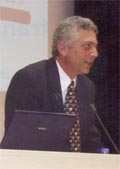 The
opening of the university's new library and culture complex has been greeted
enthusiastically. Why all the enthusiasm? The
opening of the university's new library and culture complex has been greeted
enthusiastically. Why all the enthusiasm?
In
its short 15 year history Near East University has always been noted for
making investments open to the public. Some of these include the Atatürk
Culture and Congress Centre; its Indoor Olympic Pool and the Health and
Sports Centre. All of these have rectified minor inadequacies but this time
a significant contribution has been made with the Library and Culture
Complex. This complex is one of the few information centres not only in
Cyprus but in the entire region. It will not only connect the Turkish
Cypriot community to the world but it will also serve the growing interest
foreign researchers have shown in Cyprus. This excites the community as much
as it does us and makes us proud as well. One indication of this was the
fact that the press conference we did was one of the best attended press
conferences in Northern Cyprus.
What does this
complex offer to students and the people of Northern Cyprus?
With 15,000 m2 of indoor space this gigantic complex brings
world-class standards to our island, not only in terms of size but also with
the services it offers. To give you some idea of the physical size, the
library houses 1,5 million books. It is a culture and information
access centre built to world standards with more than 150 million electronic
resources, 7500 DVDs, 17 booths for viewing films, 12
personal and group study rooms, 4 amphitheatres with seating for 1000, a
350-person theatre, a 600-person cafeteria and 600 study tables. Open 24
hours a day, the complex is open to everyone free of charge.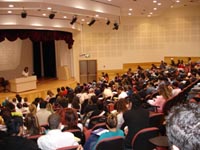 The information in the centre, which is equipped with the latest digital
technology, can be accessed from your home via the internet. If you are
on-campus, you can even access the information while sunbathing on the
grounds thanks to our wireless network. The world's library concept is
breaking new ground; it is no longer just a place to check out books. They
serve as information access centres. This is the approach that we have used
to develop services. On the one hand, we are meeting the expectations and
desires of academic life. On the other hand, we are trying to serve
vocational branches, the broader public and both civil and government
institutions. Soon our reference services will be accessible via telephone,
internet and maybe even SMS so this service which is currently available
only to academicians and researchers will be accessible by the general
public as well. You can connect to this service and find out how old the
president is or research issues of concern to you in the EU regulations. We
are improving our services and the goals we have for our collection are
truly world-class. In the next 1O years our goal is to transform the
collection we have on 1500 thousand open shelves into a collection of 2.5
million books. The closed shelf system that we will use to serve users is
already in place. When that day comes, we believe that our library will be
one of the world's finest. This obviously required massive investment.
The information in the centre, which is equipped with the latest digital
technology, can be accessed from your home via the internet. If you are
on-campus, you can even access the information while sunbathing on the
grounds thanks to our wireless network. The world's library concept is
breaking new ground; it is no longer just a place to check out books. They
serve as information access centres. This is the approach that we have used
to develop services. On the one hand, we are meeting the expectations and
desires of academic life. On the other hand, we are trying to serve
vocational branches, the broader public and both civil and government
institutions. Soon our reference services will be accessible via telephone,
internet and maybe even SMS so this service which is currently available
only to academicians and researchers will be accessible by the general
public as well. You can connect to this service and find out how old the
president is or research issues of concern to you in the EU regulations. We
are improving our services and the goals we have for our collection are
truly world-class. In the next 1O years our goal is to transform the
collection we have on 1500 thousand open shelves into a collection of 2.5
million books. The closed shelf system that we will use to serve users is
already in place. When that day comes, we believe that our library will be
one of the world's finest. This obviously required massive investment.
What goal did
you have in mind with this project?
When we opened the doors in December of 2005, we had invested 25 million
dollars. Dr. Suat I. Günsel, the founding rector of Near East University, is
the father of the project. In the words of a visiting foreign diplomat,
"Throughout history Cyprus has always been the cradle of civilization".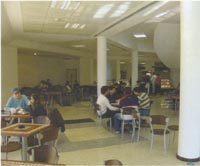 The
goal was to make that statement true again. The dream was to overcome the
weariness and fear that the society has experienced due to the problems
experienced over the past 50 years and to prove that we could once again be
the cradle of civilization. In order to compete in any field, you have to
make information and know-how readily accessible. These were what inspired
our dream. We examined the libraries of developed countries with small
populations, especially the Scandinavian countries, for inspiration
regarding function. All of these functions were localized to suit Cyprus
right down to the building's design.
For example, there was a desire for the architecture of the building to
symbolize peace, which is why the design is a combination of different
architectural styles. The imposing structure duly impresses visitors today.
In fact, you might say that it brings them back and is even addictive. Its
theatres and video conference saloons with satellite feeds were also
designed in accordance with this culture and information complex concept.
With regard to services, again we took advantage of the experiences of the
aforementioned countries in order to create a structure that would serve not
only an academic research library but also the general public. The goal was
to ensure access to all of the information that a society moving towards
integration with Europe would need. If we remember that government resources
are scarce in a small country, we see the goal was a structure that could
serve as a "national library" of world-class proportions. The
goal was to make that statement true again. The dream was to overcome the
weariness and fear that the society has experienced due to the problems
experienced over the past 50 years and to prove that we could once again be
the cradle of civilization. In order to compete in any field, you have to
make information and know-how readily accessible. These were what inspired
our dream. We examined the libraries of developed countries with small
populations, especially the Scandinavian countries, for inspiration
regarding function. All of these functions were localized to suit Cyprus
right down to the building's design.
For example, there was a desire for the architecture of the building to
symbolize peace, which is why the design is a combination of different
architectural styles. The imposing structure duly impresses visitors today.
In fact, you might say that it brings them back and is even addictive. Its
theatres and video conference saloons with satellite feeds were also
designed in accordance with this culture and information complex concept.
With regard to services, again we took advantage of the experiences of the
aforementioned countries in order to create a structure that would serve not
only an academic research library but also the general public. The goal was
to ensure access to all of the information that a society moving towards
integration with Europe would need. If we remember that government resources
are scarce in a small country, we see the goal was a structure that could
serve as a "national library" of world-class proportions. |
|
It
must have been a very difficult and comprehensive undertaking. When did the
project begin and who took care of the groundwork?
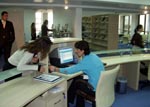 It
began five years ago. In the beginning it was supposed to be a 10-year
project but it was completed in 5 years because of the developing local and
international conditions made the need more urgent. It involved more than
finishing construction of the building. A core staff that could administrate
the facility and provide services was also necessary. You could count on one
hand the number of people in Cyprus who had training in information-document
management, so 18 months ago a staff of 50 was employed. They were put
through a full-time intensive training program. World-renowned instructors
were brought in from Turkey. The first Information and Documentation
Management Department on the island was established headed by Prof. Dr.
Aysel Yontar.
Administrative personnel were sent to Turkey's best libraries for training.
Not only was instruction provided but the existing university collection was
categorized according to
LC
rules and entered into the computer system. It
began five years ago. In the beginning it was supposed to be a 10-year
project but it was completed in 5 years because of the developing local and
international conditions made the need more urgent. It involved more than
finishing construction of the building. A core staff that could administrate
the facility and provide services was also necessary. You could count on one
hand the number of people in Cyprus who had training in information-document
management, so 18 months ago a staff of 50 was employed. They were put
through a full-time intensive training program. World-renowned instructors
were brought in from Turkey. The first Information and Documentation
Management Department on the island was established headed by Prof. Dr.
Aysel Yontar.
Administrative personnel were sent to Turkey's best libraries for training.
Not only was instruction provided but the existing university collection was
categorized according to
LC
rules and entered into the computer system.
What
kinds of difficulties were encountered?
The biggest challenge was the human element I just described. The most
challenging thing was not having trained personnel in this speciality area,
but we have overcome this. In fact, I think I am safe in saying that it is
one of our strengths now because the people we have employed cover a wide
range of fields from computer and environmental engineers to Turkish
literature and teaching English. While this might have been viewed as a
handicap, the diversity and dynamism they have brought have become a topic
of academic debate. I think that our experience and what we did during the
founding process will take its place in international literature.
In conclusion,
is there anything you would like to say to either students or the residents
of the island with regard to this important achievement?
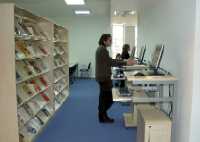 When we opened this gigantic complex, we set numerical goals for ourselves,
like how many people would use it and which services would be offered when.
We have achieved numbers greater than we expected. Statistics from the first
four weeks indicate a daily average of 5000 users. This figure has reached
5600 on some days. Currently most of the users are students or faculty
members. However, there are students from universities other than Near East
University.I don't think we have sufficiently communicated the fact that all of our
services are open to the public and free of charge. All one must do is come
to the library one time and register. Then they can view foreign journals
and daily newspapers from their homes, as well as reserve books and DVDs.
Because they are unaccustomed to such services, they may be a bit timid.
Still, I say that even if you are not going to do anything, at least come
and visit once. I am sure that they will be proud when they see our building
and what we have done. The Turkish Ambassador said, "Every tourist that
comes to the island should definitely get a tour of this place." Visiting
ambassadors from other countries made similar comments. We invite everyone
even if it is just to share our pride.*** When we opened this gigantic complex, we set numerical goals for ourselves,
like how many people would use it and which services would be offered when.
We have achieved numbers greater than we expected. Statistics from the first
four weeks indicate a daily average of 5000 users. This figure has reached
5600 on some days. Currently most of the users are students or faculty
members. However, there are students from universities other than Near East
University.I don't think we have sufficiently communicated the fact that all of our
services are open to the public and free of charge. All one must do is come
to the library one time and register. Then they can view foreign journals
and daily newspapers from their homes, as well as reserve books and DVDs.
Because they are unaccustomed to such services, they may be a bit timid.
Still, I say that even if you are not going to do anything, at least come
and visit once. I am sure that they will be proud when they see our building
and what we have done. The Turkish Ambassador said, "Every tourist that
comes to the island should definitely get a tour of this place." Visiting
ambassadors from other countries made similar comments. We invite everyone
even if it is just to share our pride.***
Caretta Magazine - February 2006 - Kemal Armağan |

 The
opening of the university's new library and culture complex has been greeted
enthusiastically. Why all the enthusiasm?
The
opening of the university's new library and culture complex has been greeted
enthusiastically. Why all the enthusiasm? The information in the centre, which is equipped with the latest digital
technology, can be accessed from your home via the internet. If you are
on-campus, you can even access the information while sunbathing on the
grounds thanks to our wireless network. The world's library concept is
breaking new ground; it is no longer just a place to check out books. They
serve as information access centres. This is the approach that we have used
to develop services. On the one hand, we are meeting the expectations and
desires of academic life. On the other hand, we are trying to serve
vocational branches, the broader public and both civil and government
institutions. Soon our reference services will be accessible via telephone,
internet and maybe even SMS so this service which is currently available
only to academicians and researchers will be accessible by the general
public as well. You can connect to this service and find out how old the
president is or research issues of concern to you in the EU regulations. We
are improving our services and the goals we have for our collection are
truly world-class. In the next 1O years our goal is to transform the
collection we have on 1500 thousand open shelves into a collection of 2.5
million books. The closed shelf system that we will use to serve users is
already in place. When that day comes, we believe that our library will be
one of the world's finest. This obviously required massive investment.
The information in the centre, which is equipped with the latest digital
technology, can be accessed from your home via the internet. If you are
on-campus, you can even access the information while sunbathing on the
grounds thanks to our wireless network. The world's library concept is
breaking new ground; it is no longer just a place to check out books. They
serve as information access centres. This is the approach that we have used
to develop services. On the one hand, we are meeting the expectations and
desires of academic life. On the other hand, we are trying to serve
vocational branches, the broader public and both civil and government
institutions. Soon our reference services will be accessible via telephone,
internet and maybe even SMS so this service which is currently available
only to academicians and researchers will be accessible by the general
public as well. You can connect to this service and find out how old the
president is or research issues of concern to you in the EU regulations. We
are improving our services and the goals we have for our collection are
truly world-class. In the next 1O years our goal is to transform the
collection we have on 1500 thousand open shelves into a collection of 2.5
million books. The closed shelf system that we will use to serve users is
already in place. When that day comes, we believe that our library will be
one of the world's finest. This obviously required massive investment. The
goal was to make that statement true again. The dream was to overcome the
weariness and fear that the society has experienced due to the problems
experienced over the past 50 years and to prove that we could once again be
the cradle of civilization. In order to compete in any field, you have to
make information and know-how readily accessible. These were what inspired
our dream. We examined the libraries of developed countries with small
populations, especially the Scandinavian countries, for inspiration
regarding function. All of these functions were localized to suit Cyprus
right down to the building's design.
For example, there was a desire for the architecture of the building to
symbolize peace, which is why the design is a combination of different
architectural styles. The imposing structure duly impresses visitors today.
In fact, you might say that it brings them back and is even addictive. Its
theatres and video conference saloons with satellite feeds were also
designed in accordance with this culture and information complex concept.
With regard to services, again we took advantage of the experiences of the
aforementioned countries in order to create a structure that would serve not
only an academic research library but also the general public. The goal was
to ensure access to all of the information that a society moving towards
integration with Europe would need. If we remember that government resources
are scarce in a small country, we see the goal was a structure that could
serve as a "national library" of world-class proportions.
The
goal was to make that statement true again. The dream was to overcome the
weariness and fear that the society has experienced due to the problems
experienced over the past 50 years and to prove that we could once again be
the cradle of civilization. In order to compete in any field, you have to
make information and know-how readily accessible. These were what inspired
our dream. We examined the libraries of developed countries with small
populations, especially the Scandinavian countries, for inspiration
regarding function. All of these functions were localized to suit Cyprus
right down to the building's design.
For example, there was a desire for the architecture of the building to
symbolize peace, which is why the design is a combination of different
architectural styles. The imposing structure duly impresses visitors today.
In fact, you might say that it brings them back and is even addictive. Its
theatres and video conference saloons with satellite feeds were also
designed in accordance with this culture and information complex concept.
With regard to services, again we took advantage of the experiences of the
aforementioned countries in order to create a structure that would serve not
only an academic research library but also the general public. The goal was
to ensure access to all of the information that a society moving towards
integration with Europe would need. If we remember that government resources
are scarce in a small country, we see the goal was a structure that could
serve as a "national library" of world-class proportions. It
began five years ago. In the beginning it was supposed to be a 10-year
project but it was completed in 5 years because of the developing local and
international conditions made the need more urgent. It involved more than
finishing construction of the building. A core staff that could administrate
the facility and provide services was also necessary. You could count on one
hand the number of people in Cyprus who had training in information-document
management, so 18 months ago a staff of 50 was employed. They were put
through a full-time intensive training program. World-renowned instructors
were brought in from Turkey. The first Information and Documentation
Management Department on the island was established headed by Prof. Dr.
Aysel Yontar.
It
began five years ago. In the beginning it was supposed to be a 10-year
project but it was completed in 5 years because of the developing local and
international conditions made the need more urgent. It involved more than
finishing construction of the building. A core staff that could administrate
the facility and provide services was also necessary. You could count on one
hand the number of people in Cyprus who had training in information-document
management, so 18 months ago a staff of 50 was employed. They were put
through a full-time intensive training program. World-renowned instructors
were brought in from Turkey. The first Information and Documentation
Management Department on the island was established headed by Prof. Dr.
Aysel Yontar. When we opened this gigantic complex, we set numerical goals for ourselves,
like how many people would use it and which services would be offered when.
We have achieved numbers greater than we expected. Statistics from the first
four weeks indicate a daily average of 5000 users. This figure has reached
5600 on some days. Currently most of the users are students or faculty
members. However, there are students from universities other than Near East
University.I don't think we have sufficiently communicated the fact that all of our
services are open to the public and free of charge. All one must do is come
to the library one time and register. Then they can view foreign journals
and daily newspapers from their homes, as well as reserve books and DVDs.
Because they are unaccustomed to such services, they may be a bit timid.
Still, I say that even if you are not going to do anything, at least come
and visit once. I am sure that they will be proud when they see our building
and what we have done. The Turkish Ambassador said, "Every tourist that
comes to the island should definitely get a tour of this place." Visiting
ambassadors from other countries made similar comments. We invite everyone
even if it is just to share our pride.
When we opened this gigantic complex, we set numerical goals for ourselves,
like how many people would use it and which services would be offered when.
We have achieved numbers greater than we expected. Statistics from the first
four weeks indicate a daily average of 5000 users. This figure has reached
5600 on some days. Currently most of the users are students or faculty
members. However, there are students from universities other than Near East
University.I don't think we have sufficiently communicated the fact that all of our
services are open to the public and free of charge. All one must do is come
to the library one time and register. Then they can view foreign journals
and daily newspapers from their homes, as well as reserve books and DVDs.
Because they are unaccustomed to such services, they may be a bit timid.
Still, I say that even if you are not going to do anything, at least come
and visit once. I am sure that they will be proud when they see our building
and what we have done. The Turkish Ambassador said, "Every tourist that
comes to the island should definitely get a tour of this place." Visiting
ambassadors from other countries made similar comments. We invite everyone
even if it is just to share our pride.